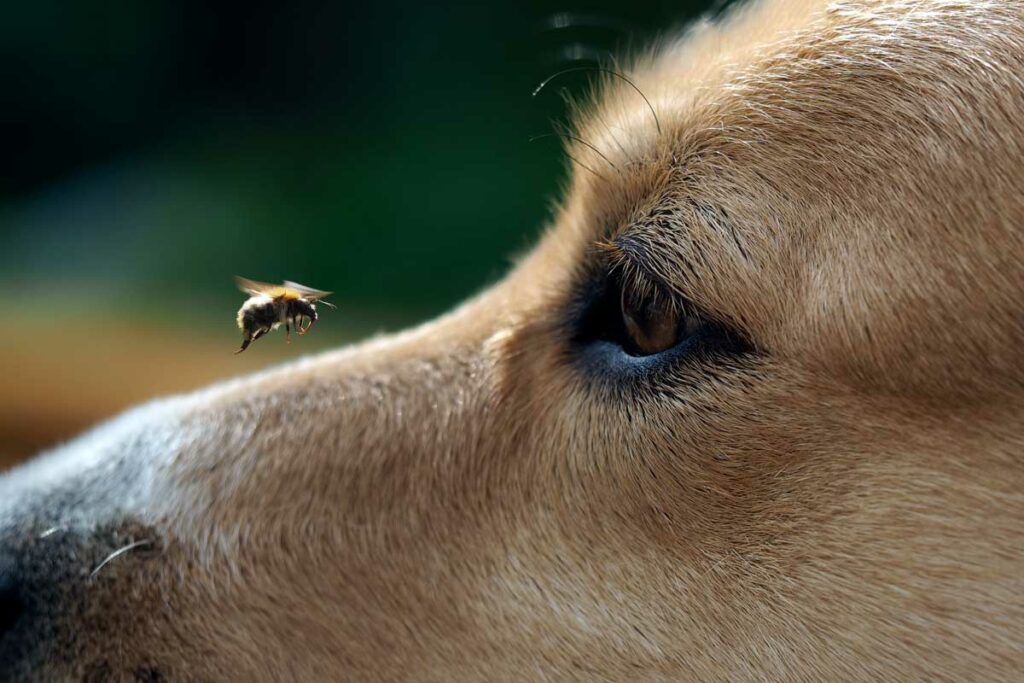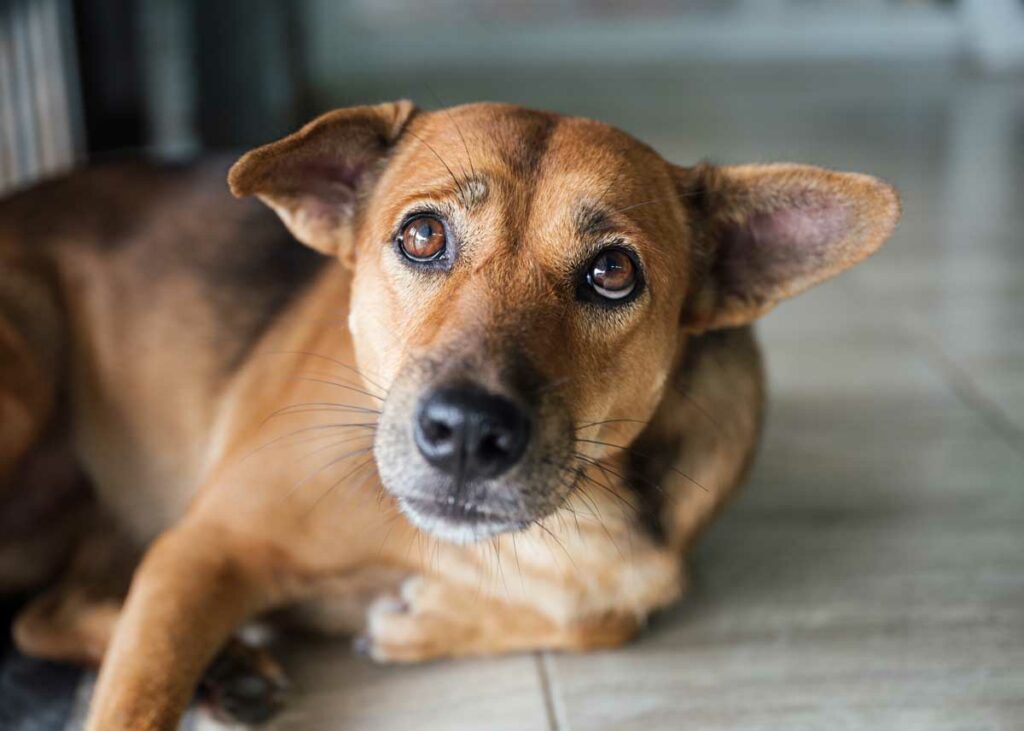The great outdoors is a playground for our furry friends, filled with interesting smells, tantalising critters, and unfortunately, the occasional bee or wasp. Have you ever seen your dog chase or snap at a buzzing insect? It’s not uncommon. Just like us, our canine companions can become the unintended target of a bee or wasp’s defence mechanism. Yes, bee and wasp stings in dogs are more prevalent than you might think.
It’s not just about the immediate pain, either. Stings can have serious implications, from allergic reactions to potential infections. As pet owners, it’s essential for us to know what to look out for and how to respond. Knowledge is power, and by understanding the implications and having the know-how on treatment, you’ll be better equipped to ensure your dog’s safety and comfort. So, let’s dive in and discover all you need to know about how to treat bee and wasp stings in dogs if they ever fall victim to one.

Why a Sting Is Serious
Imagine this: You’re enjoying a lovely picnic, and suddenly, out of the blue, you feel an intense, sharp pain in your arm. Now, consider how much more alarming and confusing this might be for your dog. When a bee or wasp stings, it’s not just an “ouch” moment. It can escalate into something far more serious.
Firstly, much like humans, dogs can have allergic reactions to stings. For some, this could lead to anaphylactic shock, a severe and potentially life-threatening allergic response. Symptoms can escalate quickly, compromising the dog’s breathing and circulation. It’s a race against time in such situations, and immediate veterinary attention becomes critical.
Beyond allergic reactions, think of the sheer pain and discomfort. A sting is, at its core, a wound. Your dog might incessantly lick, bite, or scratch the area, further aggravating it and intensifying their distress.
Also, if that sting isn’t addressed properly, there’s the lurking threat of infections. The puncture site, especially if continually irritated by a dog’s licking or scratching, can become an entry point for bacteria, leading to infections that can further harm your pet.
While a sting might seem minor, it’s a potential gateway to more severe complications. Recognising this seriousness ensures that as pet owners, we remain proactive and vigilant, and always prioritise our dog’s well-being.
Common Signs and Symptoms of a Bee or Wasp Sting
The buzzing world of bees and wasps is a mystery to our curious dogs. When these two worlds collide, it’s crucial to recognise the aftermath. If your dog gets stung, it might not be immediately evident, especially if you didn’t witness the incident. Here’s what to watch out for:
Immediate Signs
Your dog might let out a sudden yelp – a sharp, high-pitched sound signalling distress. This immediate reaction is often accompanied by them frantically biting or licking the sting site, as they try to understand and reduce the source of their sudden discomfort.
Physical Signs
Within a short time, the affected area may exhibit visible signs. Swelling is a common response, and it can be localised or more widespread. Redness often surrounds the sting site; in some cases, hives, which appear as itchy, raised welts, may form on the skin.
Behavioural Changes
Your normally playful and energetic pup might suddenly seem different. They might show signs of agitation, constantly shifting, and seeming unable to find a comfortable position. Some dogs may whimper, indicating their distress, while others could display lethargy, showing a noticeable lack of energy or enthusiasm.
Severe Reactions
It’s vital to monitor your dog closely after a sting. Severe allergic reactions can manifest as difficulty breathing, excessive drooling, or even vomiting. These symptoms warrant immediate attention and clearly indicate that you need to get your dog to a vet pronto.
Being armed with the knowledge of these signs ensures you’re not caught off guard and can provide the necessary care swiftly. Remember, your dog relies on you to interpret and act on their distress.

How to Remove a Stinger
Acting fast is the key when your dog is stung. The longer a stinger remains, the more venom it releases, exacerbating the pain and possible reactions. But it’s crucial to remove it the right way. Instead of reaching for tweezers, which might seem intuitive, use a credit card or a flat-edged object.
Gently scrape the skin surface at an angle, aiming to dislodge the stinger. Why avoid tweezers? Squeezing the stinger could force more venom into your dog. By scraping, you minimise this risk, ensuring a safer and more effective removal process. Your dog’s comfort and health are worth that extra caution.
How to Treat a Sting
A bee or wasp sting can be a daunting ordeal for your furry friend. As their trusted guardian, understanding the steps for immediate and effective treatment is vital.
Immediate Steps
- Stay Calm, Keep Them Calm – Your initial response can influence your dog’s reaction. Speak in a soothing voice and gently restrain your dog to prevent them from licking or biting the sting site, which could worsen the situation.
- Cold Compress – Reduce the inflammation by applying a cold compress to the affected area. This not only eases the swelling but can also provide some relief from the sting’s burning sensation.
Medicinal Interventions
- Antihistamines – Much like for humans, over-the-counter antihistamines can help fight allergic reactions. However, it’s essential to consult with a vet before giving any medication to ensure the correct dosage and safety.
- Pain Relief – If your dog seems to be in considerable discomfort, there are pain relief options available specifically formulated for them. Again, always check with a vet before giving any medication.
Home Remedies
- Baking Soda Paste – A mixture of baking soda and water can work wonders. Apply this paste to the sting area; it helps neutralise the venom and alleviate itching.
- Aloe Vera – Known for its soothing properties, aloe vera gel can be applied to the affected area to provide relief and promote healing.
Monitor and Act
Post-treatment, it’s essential to closely observe your dog. If you notice severe reactions like difficulty breathing, excessive drooling, or signs of distress, it’s time to seek emergency veterinary care. Remember, while these treatments can provide immediate relief, it’s always best to consult with your veterinarian, especially if symptoms persist or worsen. Your dog’s health and comfort are paramount, and being proactive in their care is the best way forward.
Wrapping Up – Stings and Your Dog’s Safety
Bee and wasp stings, while common, shouldn’t be taken lightly. Prompt and appropriate treatment is essential to alleviate discomfort and prevent complications. As a golden rule, always reach out to your veterinarian post-sting. Their expertise ensures your furry friend’s wellbeing and provides peace of mind for you. Safe and informed care is the best care.



Leave a Reply